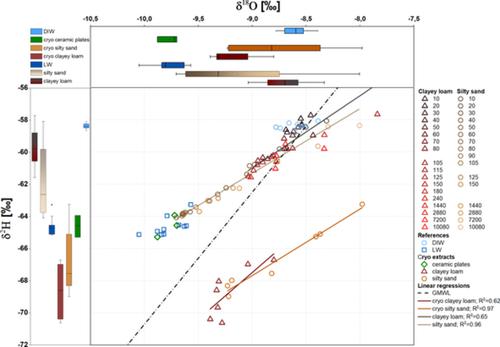当前位置:
X-MOL 学术
›
Hydrol. Process.
›
论文详情
Our official English website, www.x-mol.net, welcomes your
feedback! (Note: you will need to create a separate account there.)
Sampling soil water along the pF curve for δ2H and δ18O analysis
Hydrological Processes ( IF 2.8 ) Pub Date : 2020-09-25 , DOI: 10.1002/hyp.13916 Natalie Orlowski 1, 2 , Lutz Breuer 1, 3
Hydrological Processes ( IF 2.8 ) Pub Date : 2020-09-25 , DOI: 10.1002/hyp.13916 Natalie Orlowski 1, 2 , Lutz Breuer 1, 3
Affiliation

|
Soil water stable isotopes are widely used across disciplines (e.g., hydrology, ecology, soil science, and biogeochemistry). However, the full potential of stables isotopes as a tool for characterizing the origin, flow path, transport processes and residence times of water in different eco‐, hydro‐, and geological compartments has not yet been exploited. This is mainly due to the large variety of different methods for pore water extraction. While recent work has shown that matric potential affects the equilibrium fractionation, little work has examined how different water retention characteristics might affect the sampled water isotopic composition. Here, we present a simple laboratory experiment with two well‐studied standard soils differing in their physico‐chemical properties (e.g., clayey loam and silty sand). Samples were sieved, oven‐dried and spiked with water of known isotopic composition to full saturation. For investigating the effect of water retention characteristics on the extracted water isotopic composition, we used pressure extractors to sample isotopically labelled soil water along the pF curve. After pressure extraction, we further extracted the soil samples via cryogenic vacuum extraction. The null hypothesis guiding our work was that water held at different tensions shows the same isotopic composition. Our results showed that the sampled soil water differed isotopically from the introduced isotopic label over time and sequentially along the pF curve. Our and previous studies suggest caution in interpreting isotope results of extracted soil water and a need to better characterize processes that govern isotope fractionation with respect to soil water retention characteristics. In the future, knowledge about soil water retention characteristics with respect to soil water isotopic composition could be applied to predict soil water fractionation effects under natural and non‐stationary conditions. In this regard, isotope retention characteristics as an analog to water retention characteristics have been proposed as a way forward since matric potential affects the equilibrium fractionation between the bound water and the water vapour.
中文翻译:

沿pF曲线对土壤水进行采样以进行δ2H和δ18O分析
土壤水稳定同位素广泛用于各个学科(例如水文学,生态学,土壤科学和生物地球化学)。但是,尚未充分利用稳定同位素作为表征水在不同生态,水文和地质分区中的来源,流路,运输过程和停留时间的工具的潜力。这主要是由于提取孔隙水的方法多种多样。尽管最近的工作表明基质势会影响平衡分离,但很少有研究检查不同的保水特性如何影响采样的水同位素组成。在这里,我们提供了一个简单的实验室实验,使用了两种经过深入研究的标准土壤,这些土壤的理化性质不同(例如,黏土壤土和粉质砂土)。样品过筛 烘干并加注已知同位素组成的水至完全饱和。为了研究保水特性对提取水同位素组成的影响,我们使用了压力提取器沿pF曲线对同位素标记的土壤水进行了采样。压力提取后,我们通过低温真空提取进一步提取了土壤样品。指导我们工作的原假设是,处于不同张力下的水显示出相同的同位素组成。我们的结果表明,随时间推移,沿pF曲线,采样的土壤水在同位素上与引入的同位素标记不同。我们和以前的研究表明,在解释提取的土壤水的同位素结果时应谨慎行事,并且需要更好地表征在土壤保水特性方面控制同位素分馏的过程。将来,有关土壤水分同位素组成的土壤保水特性的知识可用于预测自然和非平稳条件下土壤水分的分馏效应。在这方面,由于基质势会影响结合水和水蒸气之间的平衡分馏,因此已提出了与水保持特性类似的同位素保持特性。关于土壤水分同位素组成的土壤保水特性的知识可用于预测自然和非平稳条件下的土壤水分分馏效应。在这方面,由于基质势会影响结合水和水蒸气之间的平衡分馏,因此已提出了与水保持特性类似的同位素保持特性。关于土壤水分同位素组成的土壤保水特性的知识可用于预测自然和非平稳条件下的土壤水分分馏效应。在这方面,由于基质势会影响结合水和水蒸气之间的平衡分馏,因此已提出了与水保持特性类似的同位素保持特性。
更新日期:2020-09-25
中文翻译:

沿pF曲线对土壤水进行采样以进行δ2H和δ18O分析
土壤水稳定同位素广泛用于各个学科(例如水文学,生态学,土壤科学和生物地球化学)。但是,尚未充分利用稳定同位素作为表征水在不同生态,水文和地质分区中的来源,流路,运输过程和停留时间的工具的潜力。这主要是由于提取孔隙水的方法多种多样。尽管最近的工作表明基质势会影响平衡分离,但很少有研究检查不同的保水特性如何影响采样的水同位素组成。在这里,我们提供了一个简单的实验室实验,使用了两种经过深入研究的标准土壤,这些土壤的理化性质不同(例如,黏土壤土和粉质砂土)。样品过筛 烘干并加注已知同位素组成的水至完全饱和。为了研究保水特性对提取水同位素组成的影响,我们使用了压力提取器沿pF曲线对同位素标记的土壤水进行了采样。压力提取后,我们通过低温真空提取进一步提取了土壤样品。指导我们工作的原假设是,处于不同张力下的水显示出相同的同位素组成。我们的结果表明,随时间推移,沿pF曲线,采样的土壤水在同位素上与引入的同位素标记不同。我们和以前的研究表明,在解释提取的土壤水的同位素结果时应谨慎行事,并且需要更好地表征在土壤保水特性方面控制同位素分馏的过程。将来,有关土壤水分同位素组成的土壤保水特性的知识可用于预测自然和非平稳条件下土壤水分的分馏效应。在这方面,由于基质势会影响结合水和水蒸气之间的平衡分馏,因此已提出了与水保持特性类似的同位素保持特性。关于土壤水分同位素组成的土壤保水特性的知识可用于预测自然和非平稳条件下的土壤水分分馏效应。在这方面,由于基质势会影响结合水和水蒸气之间的平衡分馏,因此已提出了与水保持特性类似的同位素保持特性。关于土壤水分同位素组成的土壤保水特性的知识可用于预测自然和非平稳条件下的土壤水分分馏效应。在这方面,由于基质势会影响结合水和水蒸气之间的平衡分馏,因此已提出了与水保持特性类似的同位素保持特性。











































 京公网安备 11010802027423号
京公网安备 11010802027423号